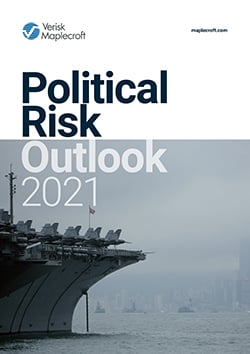Political Risk Outlook 2021 in charts
The key data visualisations behind our outlook
This insight is part of our Political Risk Outlook 2021, which explores five key themes we’re tracking for our clients this year. You can find the other themes at our #PRO21 hub, as well as related webinars.
Political systems across the globe were battered in 2020. But what comes next could shake the foundations of stability in a swathe of countries as the Covid-19 crisis enters its final act.
We project instability to increase in 68% of the 130 countries in our projections dataset, with many of these countries also at higher-than-normal risk of experiencing left tail destabilisation.
Read the insightOur data shows 88 countries are likely to be more unstable by 2023-Q1, with many also facing higher risks of left-tail destabilisation

Resource-dependent countries in sub-Saharan Africa and Latin America recorded the greatest increase in risk in 2020

34 countries have witnessed a significant increase in risk on our Resource Nationalism Index, and signs of another mining supercycle will only intensify the situation.
However, resource nationalism is evolving differently in many of the African and Latin American countries that saw the most acute increases in risk on the index. Here, we are seeing state interventionism, creeping expropriation and indigenisation emerge as the key mechanisms.
Read the insightWith the energy transition accelerating, and Covid-19 hollowing out any recovery oil made over recent years, time is running out for a number of countries that have failed to diversify their economies away from exporting fossil fuels.
When, if and how severely the storm hits each country will depend on three key factors: break-even costs, the capacity to diversify, and political resilience.
Read the insightNet oil exporters will need to adjust – one way or the other

China pivoting towards authoritarian states for key strategic resources

If China has a soft underbelly, it is its high dependency on foreign natural resources. Plugging this gap through the diversification of its hydrocarbon and mineral supply chains has become a strategic priority for Beijing.
Our data shows China is pivoting towards more autocratic regimes, which represent greater stability for its supply lines than democracies that are, or may become, hostile to Beijing.
Read the insightThe trajectory of US-China relations is unsurprisingly the geopolitical trend that is set to have the greatest impact on global markets.
Our Interstate Tensions Model identifies the US-China pairing as having one of the highest risks globally of tipping over into some form of military confrontation, with a 58% probability of such a scenario occurring in the next 12 months.
Read the insightLikelihood of geopolitical competition spilling over into a military confrontation in 2021

